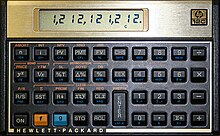HP-12C
 HP-12C | |
| Type | Programmable Financial |
|---|---|
| Manufacturer | HP |
| Introduced | 1981 |
| Discontinued | present |
| Cost | $69.99 |
| Calculator | |
| Entry mode | RPN |
| Display type | LCD Seven-segment display |
| Display size | 10 Digits |
| CPU | |
| Processor | Voyager / ARM |
| Programming | |
| Programming language(s) | RPN key stroke (fully merged) |
| Memory register | 0 … 20 |
| Program steps | 63 … 203 8 … 400 (Platinum) |
| Other | |
| Power consumption | 0.25 mW |
The HP-12C is a financial calculator made by Hewlett-Packard (HP) as part of the HP-10C series.
Functionality
The HP-12C is HP's longest and best-selling product, in continual production since its introduction in 1981. Due to its simple operation for key financial calculations, the calculator long ago became the de facto standard among financial professionals.[1] Its popularity has endured despite the fact that even a relatively simple, but iterative, process such as amortizing the interest over the life of a loan – a calculation which modern spreadsheets can complete almost instantly – can take over a minute with the HP-12C. The 1977 October edition of the HP Journal contains an article by Roy Martin, the inventor of the simple method of operation used in HP financial calculators, which describes, in detail, the mathematics and functionality built by Prof William Kahan (from UC Berkeley) and Roy Martin that is still in use today.[2]
Later HP financial calculators are many times as fast with more functions, but none has been as successful. The HP-12C's programing mode is very intuitive and works like a macro operation on a computer. Basically, the keys one would press in the calculating mode to arrive at a solution are entered in the programing mode along with logical operators (if, and, etc.) if applicable to the solution. After the programing is complete, the macro will run in the computation mode to save the user steps and improve accuracy. There are 99 lines of programmable memory on the HP-12C.
Over its lifespan, the processor's technology has been redesigned to integrate all the circuitry into a single chip and to refresh the manufacturing process (as the foundry could no longer manufacture the necessary chips, having moved on to making higher-density chips). However, HP's market research found in the late 1980s that the users did not trust results obtained too quickly and so the CPU speed was never improved from the original 200 or so kHz.[citation needed] In the late 1990s, the CPU was changed to a 3 V process and the battery was changed to a single 3 V cell.
In 2008, HP modified the design so that new production runs contain an ARM processor which runs an emulated version of previous chips. This has brought advanced possibilities such as flashing new firmware, not previously possible. HP also released a software development kit (SDK), making it possible to make new and custom operating systems. The calculator runs 20 times faster on most benchmark operations. This version is colloquially known as the HP-12C+ although HP does not market it as a different product. [citation needed]
A limited 30th anniversary edition was introduced in 2011.[3] Only 40,000 of this model were made.
The HP-12C is one of only four calculators permissible in the Chartered Financial Analyst exams, the others being its sister, the HP-12C Platinum, and the Texas Instruments BA II Plus and BA II Plus Professional.
Often referred to as a tool for "Old-ie Time-ies," critics of the HP-12C claim its early 1980s technology and style are antiquated. Proponents however, are quick to note that the HP-12C continues to be both the de jure and de facto standard of high finance.[4]
HP-12C Platinum
The HP-12C Platinum is a revision to the successful 12C. The 12C Platinum is visibly distinguished by its silver-colored upper half as opposed to the gold-colored plate on the original 12C. The Platinum has a faster processor, larger memory and more built-in functions. It allows input to be entered in algebraic mode as well as RPN mode. There are two versions of the HP-12C Platinum. The early version did not have parentheses, which often led to awkward key sequences to solve problems in algebraic mode. Newer versions of the HP-12C Platinum have parentheses, on the blue-shifted functions of the STO and RCL keys.
In 2006, Hewlett Packard released a limited edition of the 12C Platinum to commemorate the 25th anniversary of the original 12C's introduction. The 25th anniversary model has the parentheses feature.
Capitalizing on the limited availability of the anniversary edition, Victor Technology released the Victor V12 which was a budget priced clone of the HP 12C Platinum edition.
Hewlett Packard makes a HP-12C / HP-12C Platinum solutions book available as a PDF on their website.
References
- ^ For example, Goldman Sachs issues HP-12Cs to the members of each new incoming class of its analysts and associates.
- ^ Roy E. Martin: Printing Financial Calculator Sets New Standards for Accuracy and Capability, HP Journal, October 1977 (29), pp. 22–28; (PDF).
- ^ HP Limited Edition Calculator
- ^ Wall Street's Cult Calculator Turns 30
External links
- http://www.hpmuseum.org/hp12c.htm
- HP-12C and HP-12C platinum on MyCalcDB (base de données sur les calculatrices des années 70 et 80)
- Finanx FX-12C Java
- HP-12C emulator in Javascript
